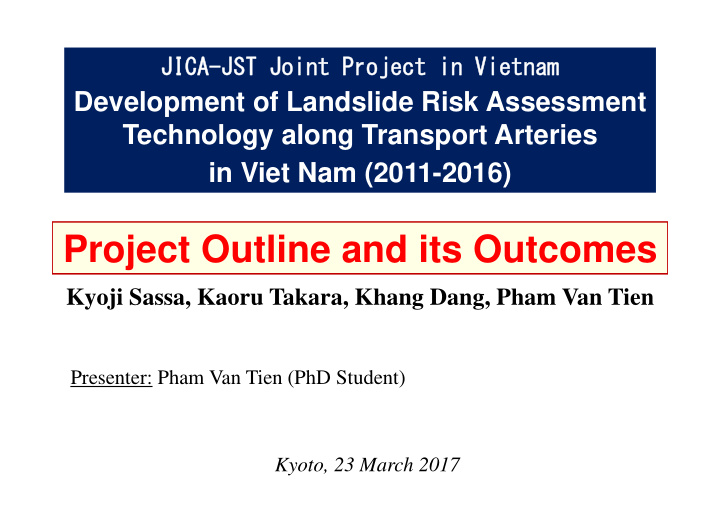



JICA-JST Joint Project in Vietnam Development of Landslide Risk Assessment Technology along Transport Arteries in Viet Nam (2011-2016) Project Outline and its Outcomes Kyoji Sassa, Kaoru Takara, Khang Dang, Pham Van Tien Presenter: Pham Van Tien (PhD Student) Kyoto, 23 March 2017
Outline - Landslides in Vietnam - The Vietnam SATREPS Project - Project Outcomes - The research at Kyoto University - Conclusion 2
Geology and Rainfall in Vietnam Cenozoic Precambrian Mesozoic Paleozoic Intrusive rock
Landslides in Vietnam • Vietnam is subject to frequent slope disasters caused by a combination of complex geology/topography and tropical monsoon. • Landslide is one of the most serious natural disasters in Vietnam. - Killed 30 people every year (Tam, 2007). - Annual damage of nearly 100 million USD (Duc, 2009). A joint cooperation project “Development of landslide risk assessment technology along transport arteries in Vietnam” funded by JICA/JST was implemented from 2011-2016
Aim of SATREPS Joint Research • Safety ensuring of transport arteries connecting north and south is the most important issue for national development. • Establishment of an effective landslide risk assessment technology suitable for Vietnam is the key issue for disaster reduction. • Technologies of landslide mapping, landslide risk identification, soil testing and computer simulation, landslide monitoring and early warning are jointly developed and transferred to Vietnam. • An extensive human resources with an advanced landslide risk assessment technology are developed through capacity development in Japan and Vietnam. • Network for landslide risk reduction is established in Vietnam, Japan and other mountainous countries.
Development of Landslide Risk Assessment Technology along Transport Arteries in Viet Nam Overall Objective Social implementation of the developed landslide risk assessment technology and early warning system will contribute to the safety ensuring of transport arteries through urban and local communities in Viet Nam. Project Purpose Landslide risk assessment technology to reduce landslide disasters along main transport arteries areas is developed, and education and capacity development for the effective use of this technology is implemented in Viet Nam. Outputs 1 Wide-area landslide mapping and identification of landslide risk area 2. Development of landslide risk assessment technology based on soil testing and computer simulation 3. Risk evaluation and development of early warning system based on landslide monitoring 4. Preparation of Integrated guidelines for the application of developed landslide risk assessment technology
As key issues to be overcome for National Development Landslide risk assessment technology is established and human resources are developed the safety ensuring of transport arteries through urban and local communities in Viet Nam. Project Cooperation Organization Institute of Transport Science and Technology (ITST) Viet Nam Landslide Association for Transport Project Director : (approved in 2014) Nguyen Xuan Khang (Director General) Vietnam National University, Hanoi Project Manager: (establishment of joint research office with Dinh Van Tien (Director for planning ) Kyoto University in 2010) Integrated Research “Development of Landslide Risk Assessment Technology” and Education (WG1) Leaders: Kyoji Sassa, Nguyen Xuan Khang, Dinh Van Tien, Toyohiko Miyagi, Hirotaka Ochiai - Planning and coordination of research, Implementation of integrated research, Capacity development - Organization of symposia, workshops, research meetings, publication and information dissemination FFPRI (WG4) Tohoku Gakuin Univ. (NPO) ICL (WG3) Leader: Hirotaka Ochiai Leader: Kyoji Sassa (WG2) Leader:Toyohiko Miyagi Landslide monitoring & Soil testing & Computer Development of early warming simulation of landslide Wide-area landslide mapping system initiation and motion & Landslide risk identification
Expected Results • Preparation of integrated guidelines for the application of developed landslide risk assessment technology and capacity development by WG1 Joint Team of all groups • Wide-area landslide mapping and identification of landslide risk area by WG2 Mapping Group • Development of landslide risk assessment technology based on soil testing and computer simulation by WG3 Testing Group • Risk evaluation and development of early warning system based on landslide monitoring by WG4 Monitoring Group
Location of the pilot area Possible NR No.3 and Hai Van Pass, Hai van Station High Speed Railway along NR NO.1 Route selection to avoid landslide disasters Da Nang Ho Chi Minh Route NR NO.2
Main Outputs of WG1 Integrated Research and Education Group - Many of ITST engineers as long-term and short–term trainees were educated in Japan (Doctor: 3 and Master: 4) - 18 of 102 text tools in “Landslide Dynamics: ISDR-ICL Landslide Interactive Teaching Tools (LITT) ” containing 1,700 pages in 2 volumes comes from the SATREPS projects in Vietnam and in Croatia. - 33 guidelines have been approving as the base of “ Technical Standard for Landslide Risk Assessment” in Vietnam. - Technology transfer/Information disemination (workshops/media) - Many journal papers and publications
Main Outputs of WG2 Mapping Group - Landslide susceptibility maps were created - Landslide risk levels were evaluated and identified - Technical methods for identifying slope deforming area and mapping landslide hazard were developed
Interpretation Haivan landslide by airphotos Aerial photos Photograph of Haivan landslides Landslide mapping
Landslide susceptibility map of the study area, along HCM from Quang Tri to Kontum 40.40% of the landslides were in the very high susceptibility areas; 42.22% of the landslides occurred in high susceptibility areas; 13.25% of the landslides occurred in middle susceptibility areas; only 4.14% of landslides occurred in low susceptibility areas. Specifically regarding high and very high susceptibility areas, 82.66% all landslides occurred there.
Mapping of Large Scale Landslide Topographic Area - 681 landslides were recognized along 100 km of HCM Route from Prao to Kham Duc Landslide inventory map along HCM road (Luong et al., 2016)
Recommend
More recommend